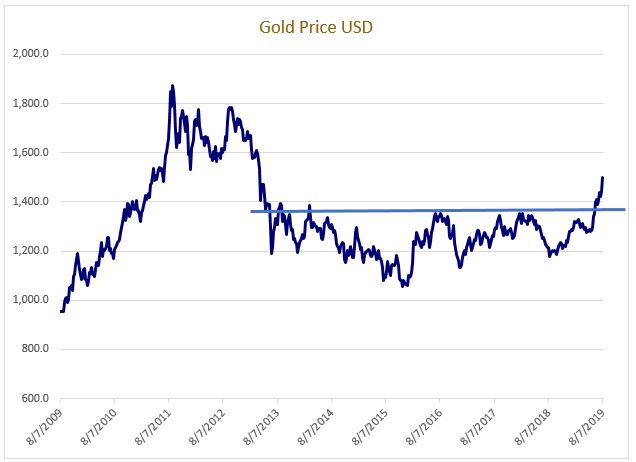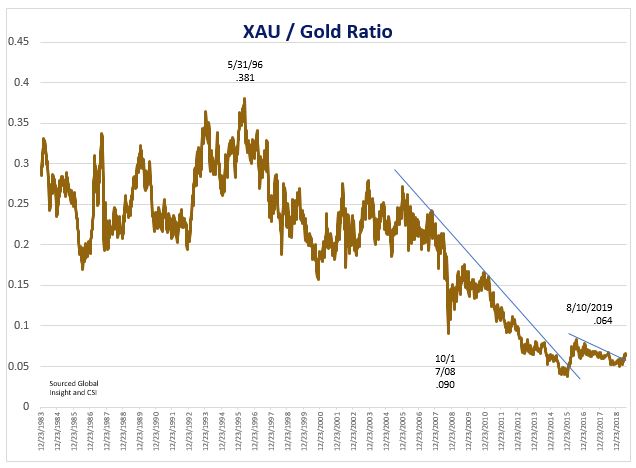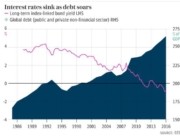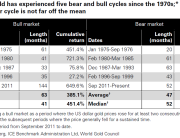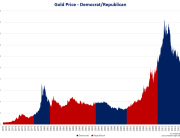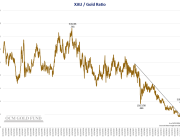Gold Price in USD Break Out
Gold in US dollars broke six years of constraint when prices moved above $1380/oz. in June 2019. Chart technicians like to say, “Price action first, the narrative will follow.”
Source: Global Insight and CSI
Gold Price Narratives:
- The Federal Reserve and world central banks failed to “normalize” interest rates and monetary policy ahead of the current global economic slowdown leaving little room to lower interest rates prior to resorting to extreme policy measures, such as Quantitative Easing1, to counter recessionary forces. Historically, the Federal Reserve2 has needed 5% of interest rate cuts to counter recessions. It only has half that to maneuver with if a recession takes hold. Bank of Japan and the European Central Bank interest rates are already at zero.
- The growth of investment grade corporate debt and government bonds carrying a negative yield has risen 50% to $13 trillion from the end of 2018, predominantly in Europe and Japan. The growth of non-incoming producing assets that are someone else’s liability will drive capital to gold, in our opinion.
- The rise of Democratic Socialism highlights the domestic conflict associated with the widening wealth gap between those with financial assets (capitalists) that have benefited from the $15 trillion central banks have pushed into the financial system since 2008 versus those who are in debt (student loans, etc.), working and living pay check to pay check. We believe democratic party political gains in the November 2020 election would no doubt hasten calls for wealth transfer through student debt forgiveness, higher minimum wages, universal health care, higher education subsidies and reversal of the Trump corporate tax reduction.
- Total U.S. Federal debt outstanding continues to outpace economic growth (5.6% vs. 2.9%) despite a ten-year economic expansion in the U.S. Total Federal debt outstanding as of May 31, 2019 was $22 trillion or a record 106% of Gross Domestic Product (GDP)3.Obligations off balance sheet that are rapidly maturing due to demographics, such as pension, social security and Medicare obligations are estimated to raise total federal liabilities to $70 trillion. We believe a recession will accelerate deficit spending possibly leading to a downgrade in U.S. credit rating through higher gold prices. Further, since 1971 gold prices are 90% correlated to total federal debt outstanding over time.
- Trade conflicts and the use of economic sanctions highlight geopolitical tension that is driving countries to seek alternatives to U.S. dollar hegemony along with heightening competition for greater share of the global economy.
- Central Bank gold purchases are at the highest level since 1967. Russia, China, India, Poland and Hungary have all added to central bank gold reserves over the first half of 2019 as central banks move to reduce reliance on dollar reserves.
- As of the end of March, worldwide debt totaled $246.5 trillion (320% of global GDP), according to the Institute of International Finance4. A level that has historically led to economic crises in individual countries. With half the debt outstanding issued by sovereign countries, the probability of direct monetization of debt in an economic downturn is likely, in our opinion.
- Broad sell-off in equities.
Gold Mining Shares
In our opinion, the low for gold mining shares was put in December 2015 when the Federal Reserve initiated its long anticipated first move off zero in the interest rate hike cycle. However, we believe the low in sentiment toward gold mining shares would not be for three more years until the fourth quarter of 2018, highlighted by Vanguard changing the mandate of its precious metals fund to a “capital cycles fund.” Basically, only a few hardy investors were left in the gold mining space by the end of last year.
Source: Global Insight and CSI
Quantitative easing1 is an unconventional monetary policy in which a central bank purchases government securities or other securities from the market, in order to, increase the money supply and encourage lending and investment.
Federal Reserve2 is the central bank of the United States and arguably the most powerful financial institution in the world. The Federal Reserve System was founded by the U.S. Congress in 1913 to provide the nation with a safe, flexible, and stable monetary and financial system.
Gross domestic product (GDP)3 is the monetary value of all the finished goods and services produced within a country’s borders in a specific time period.
Institute of International Finance4 is the global association of the financial industry.
Investors should carefully consider the investment objectives, risks, charges and expenses of the Fund. This and other important information about the Fund is contained in the Fund’s Prospectus, which can be obtained by calling 1-800-779-4681. The Prospectus should be read carefully before investing.

